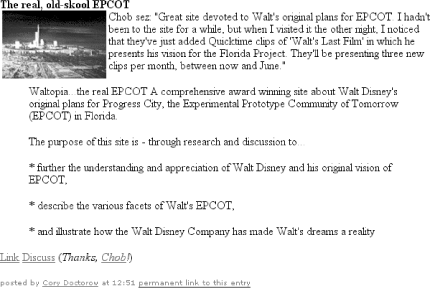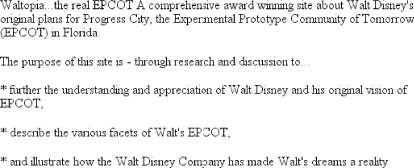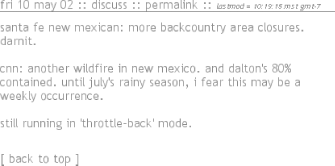

|
|
1.3 Anatomy of a Blog PostThe blog post is the atomic unit of a blog. Blogs are made of successive postings. Some blogs are updated only once a week, others get updated 30 or more times per day (the record for Boing Boing is 27 posts in one day). Everything about a blog post is optional. There are no rules for blogging. That said, Figure 1-10 shows what a post on Boing Boing looks like. Many weblogs follow a similar format. Some of the salient features of that post follow. Figure 1-10. A sample post from Boing Boing 1.3.1 TitleA post's title (see Figure 1-11) serves much the same role as a newspaper headline: to sum up the post in a few words that are meant to intrigue the reader and highlight some aspect of the story. A title visually separates your posting from the one above it. Usability guru Jakob Nielsen, in his essay on "Microcontent" (http://www.useit.com/alertbox/980906.html), warns headline writers to be aware that headlines are often viewed out of context, on search-engine result pages, in alphabetical listings (he advises leaving off leading "The"s and "A"s for this reason), and as subject-headers for email and titles for web pages. Figure 1-11. The post titleAs you'll see later, titles are also used when blogs are syndicated using a technology called RSS, in which they may appear in a list of hundreds or even thousands of other blog headlines. The point is that your title should be separable from the posting below it — informative even when taken out of context. 1.3.2 The PictureThere are, of course, copyright issues when posting an image to your blog such as the one in Figure 1-12, and technically it can be a little harder to post an image than it is post plain text (though increasingly blogging engines make this simpler). Here are some tips for posting images:
Figure 1-12. The post picture
1.3.3 The PostingThe nice thing about blogs is that they're infinite. There's no word limit, no copy fit, no sense of filling up all the space you have. If you want to write a 10,000-word polemic about your subject, go ahead and pound on the keyboard like a Fox celebrity boxer. That said, blog entries typically come in packs — you hardly ever get a blog entry all on its lonesome. So the tradition is to keep blog entries short — a screenful or less. Postings to Jorn Barger's Robot Wisdom weblog are a single, punchy sentences. Movable Type and some other blogging engines allow you to create a "preview" block of text that links to a "full text" block for longer entries. Infinite space aside, as with all writing, your blog entry should take exactly as many words as it needs to make its point, and not one word more. Figure 1-13. The post body Some blog authors play at mystery in their postings, writing deliberately obscure things like "Boy, this sure must have hurt!" and nothing else. The idea is to pique the reader's interest with your pith and jocularity, so that he follows the link to find out what it is that hurt so much. I try never to do this, operating on the principle that the best way to get someone to follow a link is to describe what's on the other end of it and why it's interesting, as in Figure 1-13. 1.3.4 The QuoteSometimes, the best way to explain why a page is blogworthy is to include a brief quote or two. As with pictures, there are copyright issues associated with this, because fair use is generally held to include only excerpts, not the whole text (though some would argue that the standard for fair use is the minimum amount necessary to make the point, which could, conceivably, be the whole thing). It's traditional to set off quotes from the main body of a blog post (see Figure 1-14) with some combination of blockquote tags and stylistic changes, such as italicizing. Long blocks of italic textare difficult to read, though. Figure 1-14. A quote from a referenced page 1.3.5 The LinkThere are a lot of little niceties that comprise many blog entries. On Boing Boing, the convention is to limit the number of links per entry to one, at the very end of the entry, with the hot-text being "Link" (see Figure 1-15). We do it this way for a couple of reasons, which we've listed here.
Compare the Boing Boing approach to that of Memepool (http://www.memepool.org), with sentences such as "Professional wrestlers are bigger than ever" where every word is a link to a different page related to the blog entry. The Memepool style has its followers. There is no right answer here. Figure 1-15. A link1.3.6 Discuss LinkDiscussion links (see Figure 1-16) are links to web-based message boards where your readers can talk about your entries. Some blogs don't bother with discussions, while others are defined by the communities in their discussion areas. Some blogs have a different discussion area for each post, others have a single Ür-message-board with a long running discussion about the posts on the front page. Figure 1-16. A discuss linkDepending on which blog tool you use to maintain your blog, you may have to use a third-party service to host your discussions. On Boing Boing, we use QuickTopic (http://www.quicktopic.com), creating a new topic for each post. Some blogging tools have message boards built in. With Movable Type, for example, you just check a box labeled Allow Comments when you're creating your post, and Movable Type automatically generates a new discussion board and puts a link to it on your post. Likewise, Radio UserLand has an automated facility for adding discussion boards to blog entries. Discussion boards can be a vital part of a healthy blog. They transform your blog from a broadcast into a conversation, where you and your readers can discuss the items you post. Be warned, though: message boards abstract discussion away from the social cues that we use when we talk face-to-face. Decent people can be breathtakingly abusive on a message board. A single jerk can ruin a fruitful discussion with persistent bile. If you run a blog, you will eventually attract such a jerk (a "troll" in Internet parlance), and he will make your life absolutely miserable. When confronted with a troll, you have three immediate temptations:
Resist these temptations. Arguing back is fruitless. Internet trolls live to engage otherwise sane people in pointless, heated debate. Deleting the post sets up an arms race, where your troll returns again and again, assuming new identities, until you find yourself spending all your time hunting down and eliminating offensive posts, while your blog idles away, untended and static. Deleting the message board altogether satisfies the troll's victory condition: he has silenced your readers with his vitriol. Take a lesson from free speech advocates: the answer to bad speech is more speech. Ignore your troll (and encourage your readers to do the same), while you continue to have your discussion. Trolls really do disappear if no one pays them any attention. Some message boards have email gateways, allowing you to read and post from your mail client. If your message board has this option, use it and avail yourself to your mailer's filters and delete the troll's posts unread. Matt Haughey runs a sprawling and excellent group blog called Metafilter (http://www.metafilter.com), where heated debate often flares. Matt jokes about installing the ultimate anti-troll measure: a filter that makes it appear to the troll as though his posts are being sent to the Metafilter message boards but makes those posts invisible to all other users, removing the temptation to encourage the troll by responding to him. 1.3.7 AttributionThe currency of the Distributed Republic of Blogistan is the link. One link equals approximately $0.00. Even so, links aren't worthless. There is no shame in getting links for your blog from other bloggers — indeed, one of the blogiverse's finest characteristics is its ability to examine a single story from a thousand angles, wearing it as smooth as a riverstone as it is handled by a horde of self-appointed analysts. So no blogger will complain that you are stealing from her if you reproduce her links on your site, but woe to the blogger who does so without attribution (see Figure 1-17). If we find a link on your blog, we don't need to ask your permission to post it on ours, but we'd be very rude indeed if we didn't link back to your site. Figure 1-17. Attribution with linkAttributing links establish the chain of authorship. They drive your readers to the sites that you read. They are the invaluable payback from one blogger to another, the indispensable, virtual high-five. On Boing Boing, we attribute in two ways:
Other blogs handle attribution in their own way. Some do it inline ("Found on Metafilter: Yet another domain hijacking"). Some do it very briefly, at the beginning or the end of the post ("Check out this amazing Flash animation. [slashdot]", "Scripting News: More cease and desist letters from the Church of Scientology"). 1.3.8 By-LineBlogs are written by people, not PR departments or staff writers. Blog entries are almost always signed by their authors (see Figure 1-18), even if the author uses a pseudonym. On Boing Boing, we link the by-lines to the author's email address, so readers can respond personally to a story with one click. Some sites use feedback forms to avoid putting their email addresses on the Web where they can be harvested by spammers. Figure 1-18. By-lineThe by-line is part of the Internet personal publishing revolution. Before the rise of online publishing, the average person's only chance to write something for public consumption that carried her name was a letter to the editor. The real world is thick with unattributed, seemingly authorless material — who wrote that Associated Press story on page two of your morning paper, or the newscast that you heard at the top of the hour? Who wrote the instructions that came with your VCR or the warning label on your gas cap? Blogs are covered with by-lines. Bloggers gleefully lay claim to their words and bear blame when those words arouse ire in their readers. 1.3.9 Permanent LinkThe front page of a blog is a book written on water. A busy blog rotates its entire front page every day or two. Links to items on the front page of a blog are only good until sufficient new material is added to the page to push the items off into oblivion. The solution is permanent links (see Figure 1-19). Most blogging tools generate two copies of every post you create: one on the front page and one on a permanent, sequential archive page. It's up to you how much material you want on each archive page. At Boing Boing, we put a month's worth of links (300-400) on each archive page. This keeps the number of archive pages to a minimum, but it does mean that digging through the archives can take a long time, as each archive page has to load and render in your browser. Some bloggers archive a week at a time; especially wordy bloggers may opt to generate a new archive for every day. Figure 1-19. Permanent linkYour blogging tool will generate a permanent link to the archive copy of each new post automatically. It's up to you to choose where that link goes and what it looks like. As you can see on Boing Boing, we put permanent links underneath each post. Some other suggestions:
We like the Boing Boing approach because it makes it very clear where the permanent link is. Other bloggers who want to link to my posts can quickly and easily locate our permalinks, even if they've never been to Boing Boing before. Figure 1-20. An icon used to indicate a permanent link in Doc Searls's Radio blog Figure 1-21. A special typographic character (#) used to indicate a permanent link on Rael Dornfest's Blosxom blog Figure 1-22. An abbreviation ("permalink") used to indicate a permanent link on Dangerous Meta |

|
|